Mechanical Analysis of the Quasi-Static and Dynamic Composite Action in PV Modules with Viscoelastic Encapsulant
Abstract
:1. Introduction
2. Research Methods
2.1. Mechanical Analysis of the Sandwich Section
2.2. Reference PV Module
2.3. Structural Analysis of the PV Composite Section
2.4. Structural Performance Indicators for the Glass Cover
2.5. Analytical Modelling and Shear Bond Efficiency
3. Analysis of Analytical Results
3.1. Encapsulant Stiffness and Shear Coupling
3.2. Encapsulant Stiffness and Mechanical Capacity
3.3. Minimum Shear Bond Efficiency Detection
3.4. Interfacial Stress Peaks
3.5. Dynamic Bending Stiffness
- when and thus (layered limit), and
- with a rigid shear coupling ( and at the monolithic limit).
- A dynamic/impulsive mechanical load typically corresponds to a stiffer response of the viscoelastic encapsulant. The shorter is the time-loading, and the stiffer is the shear bond, thus the PV module bending response ideally tends to the “monolithic” bound. Structurally speaking, the glass cover can benefit from a more pronounced composite action of the sandwich section, with more uniform distribution of internal stresses. It is expected that the maximum deflection is also reduced, thanks to the increased bending stiffness of the PV module.
- A long-term mechanical load is associated with the progressive relaxation of the viscoelastic encapsulant, which is implicitly associated with a bending stiffness loss for the PV model as a whole, with a mechanical behaviour similar to the “layered” configuration.
- All the intermediate scenarios are characterized by a bending performance that is associated with important modifications in the shear bond efficiency and composite action of the PV section, with major effects in the load-bearing and electrical components.
3.6. Mechanical Boundaries and Load Distribution
- “SS (q)”: two short edges supported (with long edges unrestrained) and a uniformly distributed load q;
- “4PF (q)”: four point-fixing restraints at the corners of the PV module, with uniformly distribute load q;
- “SSSS (P)”: four simply supported edges and a mechanical load on a central 10 × 10 cm surface.
4. Conclusions
Author Contributions
Funding
Institutional Review Board Statement
Informed Consent Statement
Data Availability Statement
Conflicts of Interest
References
- Sander, M.; Dietrich, S.; Pander, M.; Ebert, M.; Bagdahn, J. Systematic investigation of cracks in encapsulated solar cells after mechanical loading. Sol. Energy Mater. Sol. Cells 2013, 111, 82–89. [Google Scholar] [CrossRef]
- Dietrich, S.; Pander, M.; Sander, M.; Ebert, M. Mechanical Investigations on Metallization Layouts of Solar Cells with Respect to Module Reliability. Energy Procedia 2013, 38, 488–497. [Google Scholar] [CrossRef]
- Dabaghzadeh, N.; Eslami, M. Temperature distribution in a photovoltaic module at various mounting and wind conditions: A complete CFD modelling. J. Renew. Sustain. Energy 2019, 11, 053503. [Google Scholar] [CrossRef]
- Li, Y.; Xie, L.; Zhang, T.; Wu, Y.; Sun, Y.; Ni, Z.; Zhang, J.; He, B.; Zhao, P. Mechanical analysis of photovoltaic panels with various boundary condition. Renew. Energy 2020, 145, 242–260. [Google Scholar] [CrossRef]
- Hartley, J.Y.; Owen-Bellini, M.; Truman, T.; Maes, A.; Elce, E.; Ward, A.; Khraishi, T.; Roberts, S.A. Effects of Photovoltaic Module Materials and Design on Module Deformation Under Load. IEEE J. Photovolt. 2020, 10, 838–843. [Google Scholar] [CrossRef]
- Corrado, M.; Infuso, A.; Paggi, M. Simulated hail impacts on flexible photovoltaic laminates: Testing and modelling. Meccanica 2017, 52, 1425–1439. [Google Scholar] [CrossRef]
- Chakraborty, S.; Haldkar, A.K.; Kumar, N.M. Analysis of the hail impacts on the performance of commercially available photovoltaic modules of varying front glass thickness. Renew. Energy 2023, 203, 345–356. [Google Scholar] [CrossRef]
- Gong, J.; Xie, L.; Li, Y.; Ni, Z.; Wei, Q.; Wu, Y.; Cheng, H. Analysis of the Impact Resistance of Photovoltaic Panels Based on the Effective Thickness Method. J. Renew. Mater. 2021, 10, 33–51. [Google Scholar] [CrossRef]
- IEC 61215-2:2021; Terrestrial Photovoltaic (PV) Modules—Design Qualification and Type Approval—Part 2: Test Procedures. International Electrotechnical Commission: Geneve, Switzerland, 2021.
- Shah, N.A.; Gul, R.M.; Khan, Z.H. Mechanical Integrity and Failure Analysis of Photovoltaic Modules under Simulated Snow Loads Using Pneumatic Airbag Setup. J. Power Energy Eng. 2022, 10, 1–13. [Google Scholar] [CrossRef]
- Papargyri, L.; Papanastasiou, P.; Georghiou, G.E. Effect of materials and design on PV cracking under mechanical loading. Renew. Energy 2022, 199, 433–444. [Google Scholar] [CrossRef]
- Dietrich, S.; Pander, M.; Sander, M.; Schulze, S.-H.; Ebert, M. Mechanical and Thermo-Mechanical Assessment of Encapsulated Solar Cells by Finite-Element-Simulation. In Proceedings of the SPIE—The International Society for Optical Engineering—Reliability of Photovoltaic Cells, Modules, Components, and Systems III, San Diego, CA, USA, 3–5 August 2010; Volume 7773, p. 77730F. [Google Scholar] [CrossRef]
- Haghi, M.; Aßmus, M.; Naumenko, K.; Altenbach, H. Mechanical Models and Finite-Element Approaches for the Structural Analysis of Photovoltaic Composite Structures: A Comparative Study. Mech. Compos. Mater. 2018, 54, 415–430. [Google Scholar] [CrossRef]
- Aßmus, M.; Bergmann, S.; Naumenko, K.; Altenbach, H. Mechanical behaviour of photovoltaic composite structures: A parameter study on the influence of geometric dimensions and material properties under static loading. Compos. Commun. 2017, 5, 23–26. [Google Scholar] [CrossRef]
- Naumenko, K.; Eremeyev, V.A. A layer-wise theory for laminated glass and photovoltaic panels. Compos. Struct. 2014, 112, 283–291. [Google Scholar] [CrossRef]
- Li, G.; Wang, F.; Feng, F.; Wei, B. Hot Spot Detection of Photovoltaic Module Based on Distributed Fiber Bragg Grating Sensor. Sensors 2022, 22, 4951. [Google Scholar] [CrossRef] [PubMed]
- Dadaniya, A.; Datla, N.V. Degradation prediction of encapsulant-glass adhesion in the photovoltaic module under outdoor and accelerated exposures. Sol. Energy 2020, 208, 419–429. [Google Scholar] [CrossRef]
- Dobra, T.; Vollprecht, D.; Pomberger, R. Thermal delamination of end-of-life crystalline silicon photovoltaic modules. Waste Manag. Res. 2022, 40, 96–103. [Google Scholar] [CrossRef]
- Sangpongsanont, Y.; Chuangchote, S.; Chenvidhya, D.; Kirtikara, K. Annual expansion in delamination of front encapsulant in tropical climate Field-Operated PV modules. Sol. Energy 2023, 262, 111850. [Google Scholar] [CrossRef]
- Meena, R.; Pareek, A.; Gupta, R. A comprehensive Review on interfacial delamination in photovoltaic modules. Renew. Sustain. Energy Rev. 2024, 189 Pt A, 113944. [Google Scholar] [CrossRef]
- Jaszczur, M.; Hassan, Q.; Teneta, J.; Majewska, E.; Zych, M. An analysis of temperature distribution in solar photovoltaic module under various environmental conditions. MATEC Web. Conf. 2018, 240, 04004. [Google Scholar] [CrossRef]
- Repins, I.L.; Jordan, D.C.; Woodhouse, M.; Theristis, M.; Stein, J.S.; Seigneur, H.P.; Colvin, D.J.; Karas, J.F.; McPherson, A.N.; Deline, C. Long-term impact of light- and elevated temperature-induced degradation on photovoltaic arrays. MRS Bull. 2023, 48, 589–601. [Google Scholar] [CrossRef]
- Theristis, M.; Stein, J.S.; Deline, C.; Jordan, D.; Robinson, C.; Sekulic, W.; Anderberg, A.; Colvin, D.J.; Walters, J.; Seigneur, H.; et al. Onymous early-life performance degradation analysis of recent photovoltaic module technologies. Prog. Photovolt. Res. Appl. 2022, 31, 149–160. [Google Scholar] [CrossRef]
- Romer, P.; Pethani, K.B.; Beinert, A.J. Effect of inhomogeneous loads on the mechanics of PV modules. Prog. Photovolt. Res. Appl. 2024, 32, 84–101. [Google Scholar] [CrossRef]
- Pander, M.; Dietrich, S.; Schulze, S.-H.; Eitner, U.; Ebert, M. Thermo-mechanical assessment of solar cell displacement with respect to the viscoelastic behaviour of the encapsulant. In Proceedings of the 12th International Conference on Thermal, Mechanical & Multi-Physics Simulation and Experiments in Microelectronics and Microsystems, Linz, Austria, 18–20 April 2011. [Google Scholar] [CrossRef]
- Rodrigues, T.; Jordão, S.; Bedon, C. Long-term effects on structural glass beam. In Proceedings of the XI Congresso de Construção Metálica e Mista, Coimbra, Portugal, 23–24 November 2017; pp. 933–942. [Google Scholar]
- Nielsen, J.H.; Jónsson, B.G.; Bedon, C. A novel concept for a reinforced glass beam carrying long term loads. Glas. Struct. Eng. 2020, 5, 233–245. [Google Scholar] [CrossRef]
- Makrides, G.; Theristis, M.; Bratcher, J.; Pratt, J.; Georghiou, G.E. Five-year performance and reliability analysis of monocrystalline photovoltaic modules with different backsheet materials. Sol. Energy, 2018, 171, 491–499. [Google Scholar] [CrossRef]
- Bedon, C. Diagnostic analysis and dynamic identification of a glass suspension footbridge via on-site vibration experiments and FE numerical modelling. Compos.Struct. 2019, 216, 366–378. [Google Scholar] [CrossRef]
- Bedon, C. Issues on the Vibration Analysis of In-Service Laminated Glass Structures: Analytical, Experimental and Numerical Investigations on Delaminated Beams. Appl. Sci. 2019, 9, 3928. [Google Scholar] [CrossRef]
- CNR-DT 210/2013; Istruzioni Per la Progettazione, L’esecuzione ed il Controllo di Costruzioni con Elementi Strutturali di Vetro. National Research Council of Italy (CNR): Rome, Italy, 2013. (In Italian)
- Galuppi, L.; Royer-Carfagni, G. The effective thickness of laminated glass plates. J. Mech. Mater. Struct. 2012, 7, 375–400. [Google Scholar] [CrossRef]
- Serafinavičius, T.; Lebet, J.-P.; Louter, C.; Lenkimas, T.; Kuranovas, A. Long-term Laminated Glass Four Point Bending Test with PVB, EVA and SG Interlayers at Different Temperatures. Procedia Eng. 2013, 57, 996–1004. [Google Scholar] [CrossRef]
- Paggi, M.; Sapora, A. An Accurate Thermoviscoelastic Rheological Model for Ethylene Vinyl Acetate Based on Fractional Calculus. Int. J. Photoenergy 2015, 2015, 252740. [Google Scholar] [CrossRef]
- Andreozzi, L.; Bati, S.B.; Fagone, M.; Ranocchiai, G.; Zulli, F. Weathering action on thermo-viscoelastic properties of polymer interlayers for laminated glass. Constr. Build. Mater. 2015, 98, 757–766. [Google Scholar] [CrossRef]
- Antolinc, D. Three-Point Bending Test of Laminated Glass With PVB and EVA Interlayers at Elevated Temperature. In Proceedings of the Challenging Glass 7—Conference on Architectural and Structural Applications of Glass, Ghent Belis, Belgium, 4 September 2020; Belis, J.L.I.S., Bos, F.P., Louter, P.C., Eds.; Ghent University: Ghent, Belgium, 2020. ISBN 978-94-6366-296-3. [Google Scholar] [CrossRef]
- Bornemann, S.; Henning, S.; Naumenko, K.; Pander, M.; Thavayogarajah, N.; Würkner, M. Strength analysis of laminated glass /EVA interfaces: Microstructure, peel force and energy of adhesion. Compos. Struct. 2022, 297, 115940. [Google Scholar] [CrossRef]
- Knight, J.T.; El-Sisi, A.A.; Elbelbisi, A.H.; Newberry, M.; Salim, H.A. Mechanical Behavior of Laminated Glass Polymer Interlayer Subjected to Environmental Effects. Polymers 2022, 14, 5113. [Google Scholar] [CrossRef]
- EN 572-2:2004; Glass in buildings—Basic Soda Lime Silicate Glass Products. European Committee for Standardization (CEN): Brussels, Belgium, 2004.
- EN 485-2; Aluminium and Aluminium Alloys—Sheet, Strip and Plate—Part 2: Mechanical Properties. European Committee for Standardization (CEN): Brussels, Belgium, 2016.
- Tedlar Technical Bulletin. Mechanical Properties of Tedlar Films; DuPont™ Tedlar: Wilmington, DE, USA, 2020; 6p. [Google Scholar]
- Udi, U.J.; Yussof, M.M.; Ayagi, K.M.; Bedon, C.; Kamarudin, M.K. Environmental degradation of structural glass systems: A review of experimental research and main influencing parameters. Ain Shams Eng. J. 2023, 14, 101970. [Google Scholar]
- Zhang, T.; Xie, L.; Li, Y.; Mallick, T.K.; Wei, Q.; Hao, X.; He, B. Experimental and Theoretical Research on Bending Behavior of Photovoltaic Panels with a Special Boundary Condition. Energies 2018, 11, 3435. [Google Scholar] [CrossRef]
- Tummalieh, A.; Beinert, A.J.; Reichel, C.; Mittag, M.; Neuhaus, H. Holistic design improvement of the PV module frame: Mechanical, optoelectrical, cost, and life cycle analysis. Prog. Photovolt. Res. Appl. 2022, 30, 1012–1022. [Google Scholar] [CrossRef]
- Kontges, M.; Siebert, M.; Morlier, A.; Illing, R.; Bessing, N.; Wegert, F. Impact of transportation on silicon wafer-based PV modules. Prog. Photovolt. Res. Appl. 2016, 24, 1085–1095. [Google Scholar] [CrossRef]
- Clough, R.W.; Penzien, J. Dynamics of Structures; McGraw-Hill: New York, NY, USA, 1993; ISBN 0-07-011394-7. [Google Scholar]
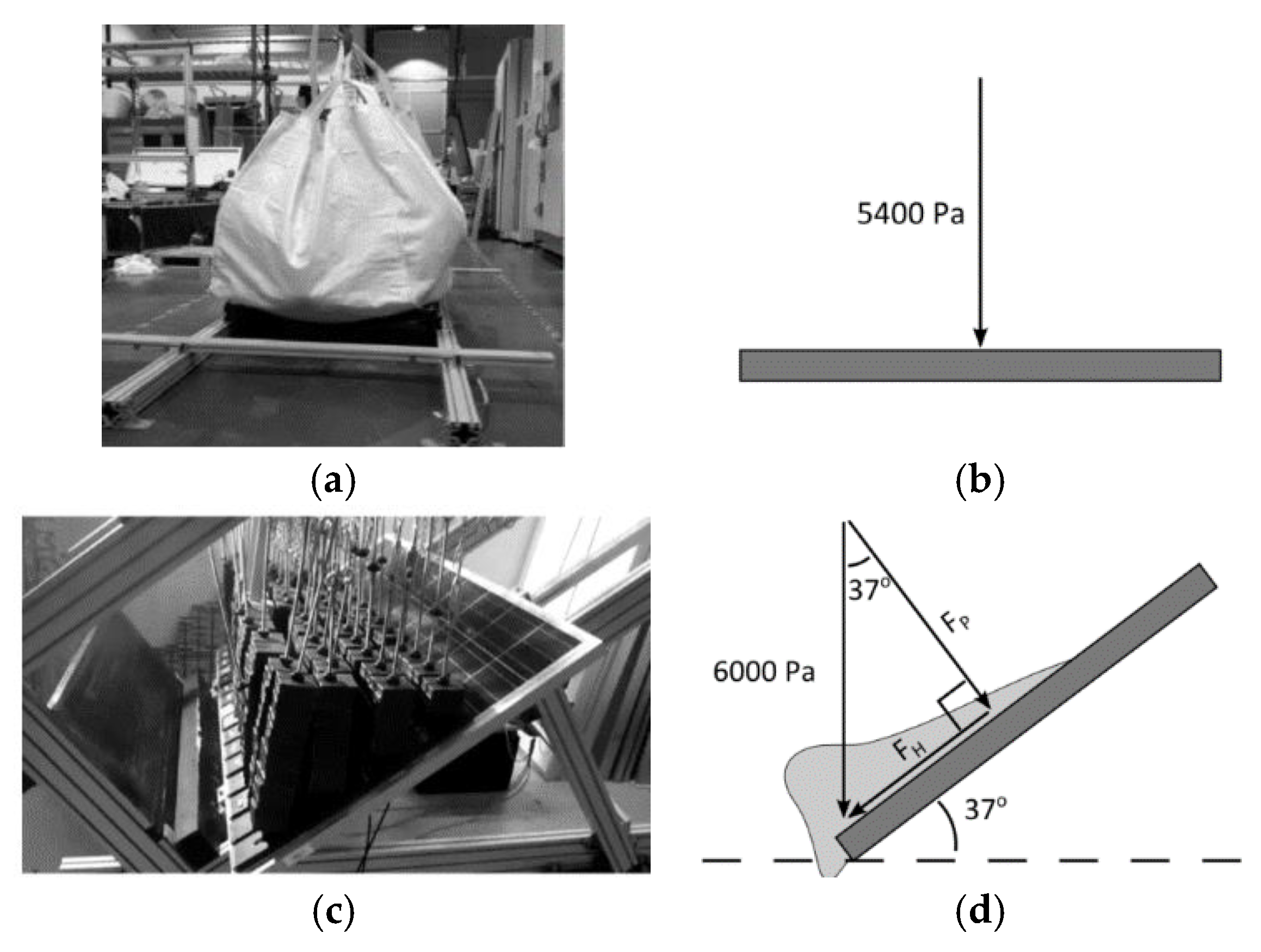
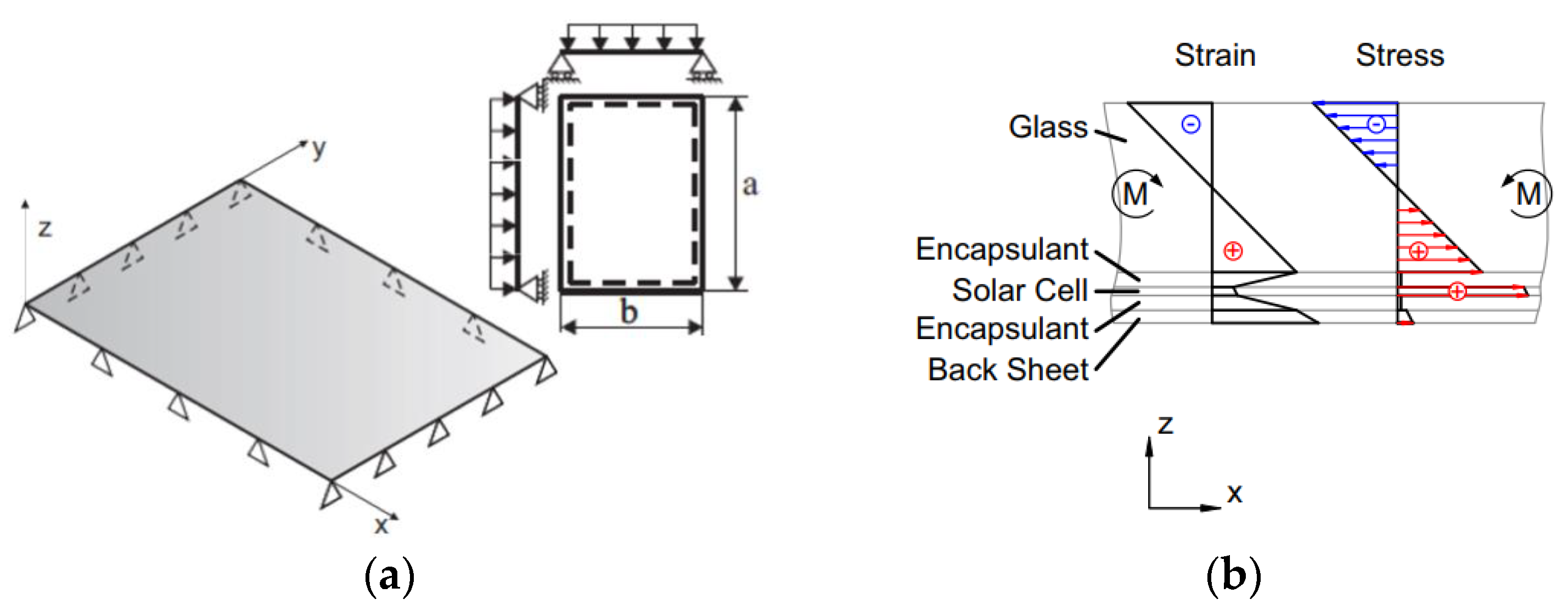

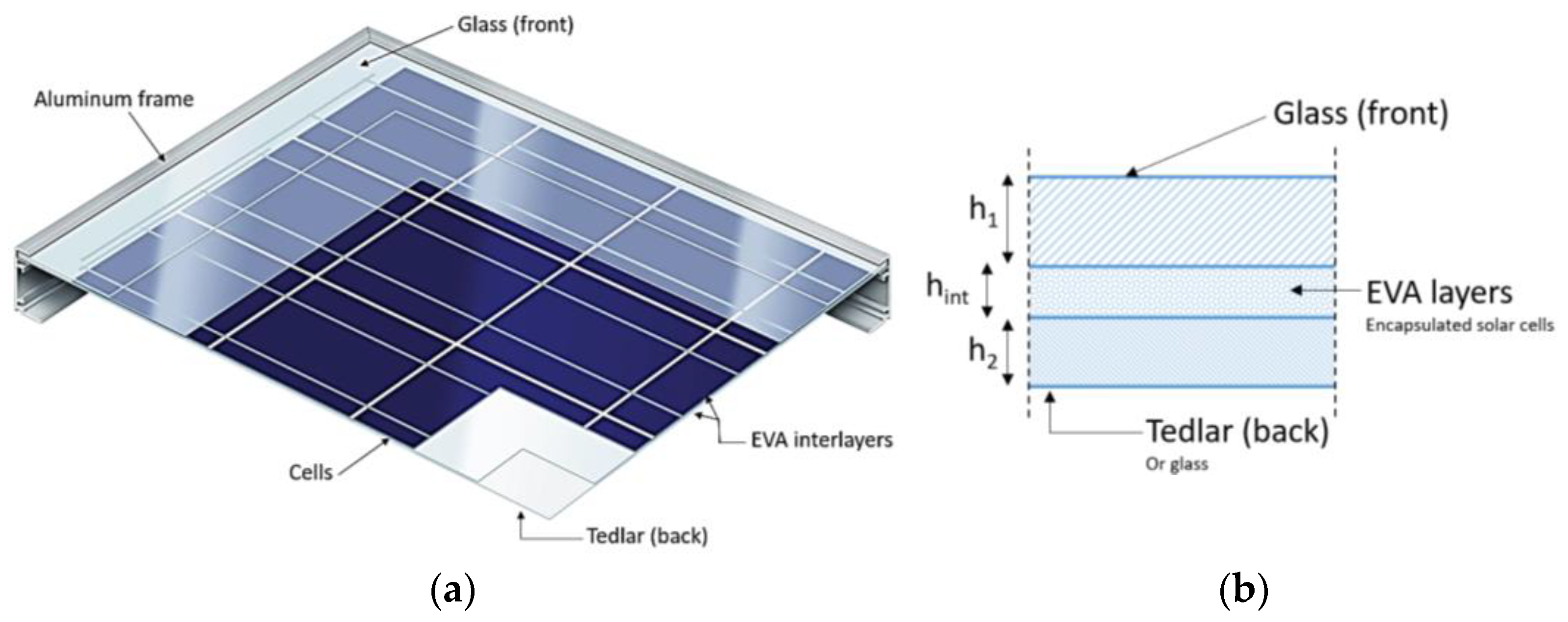
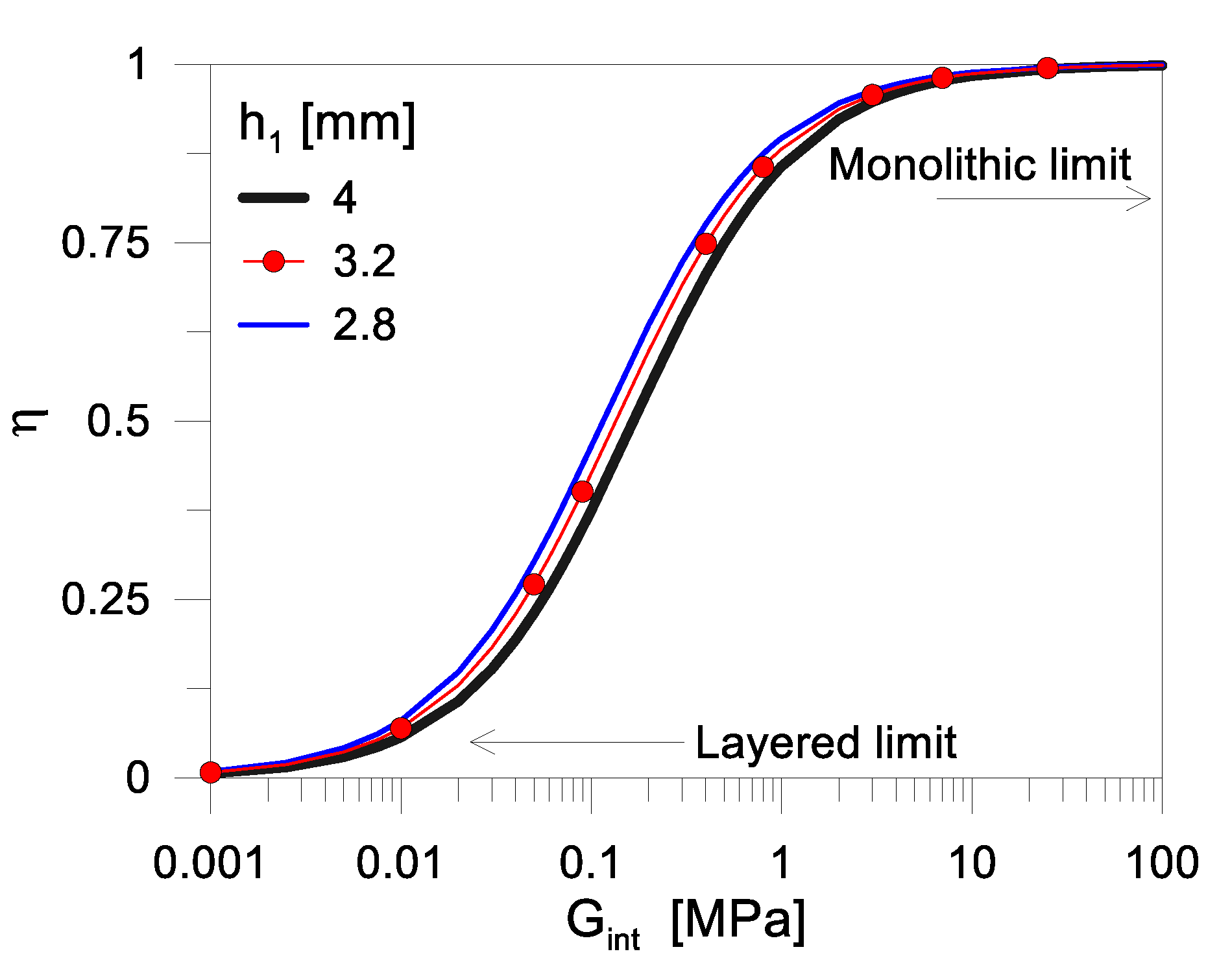
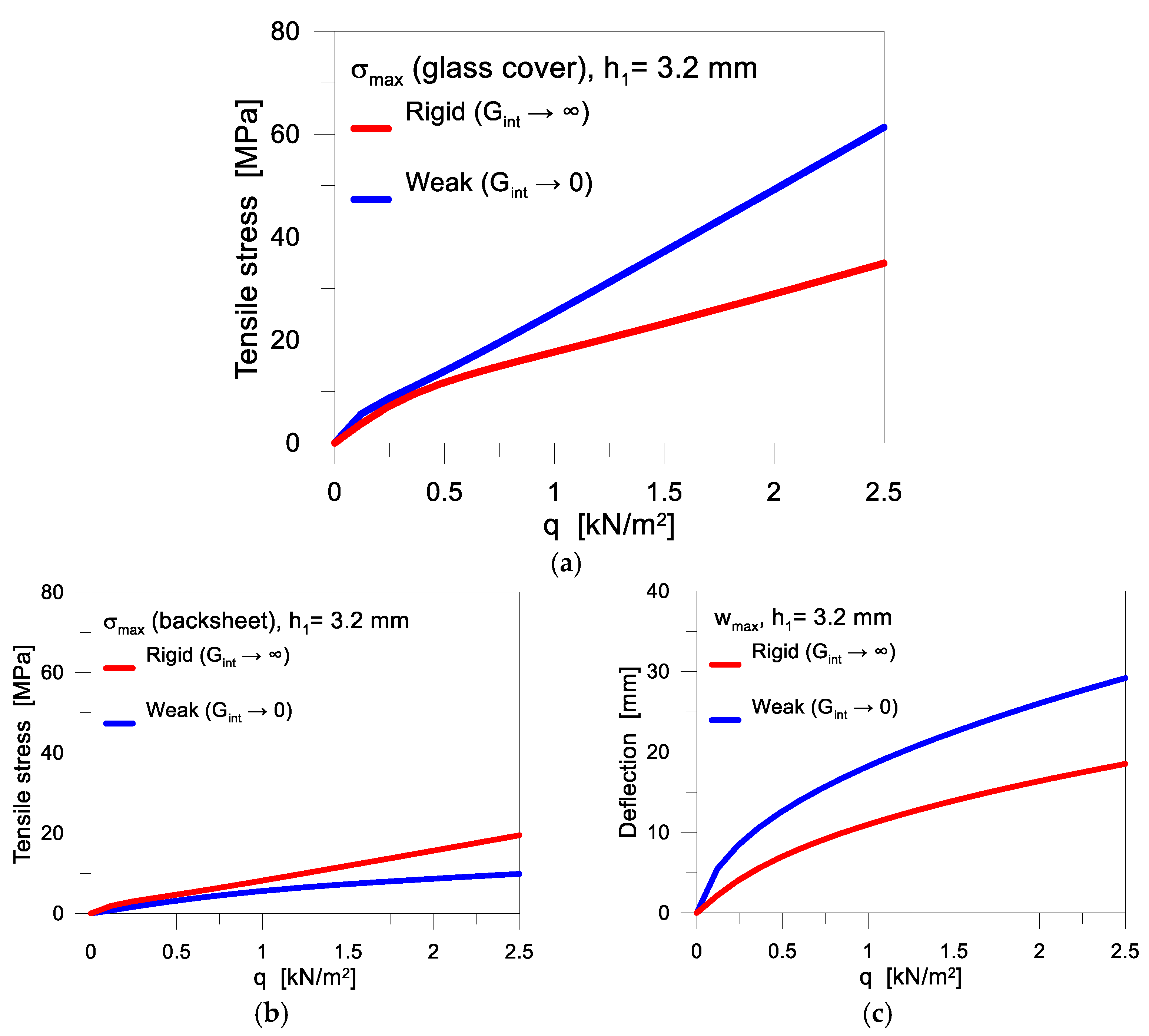

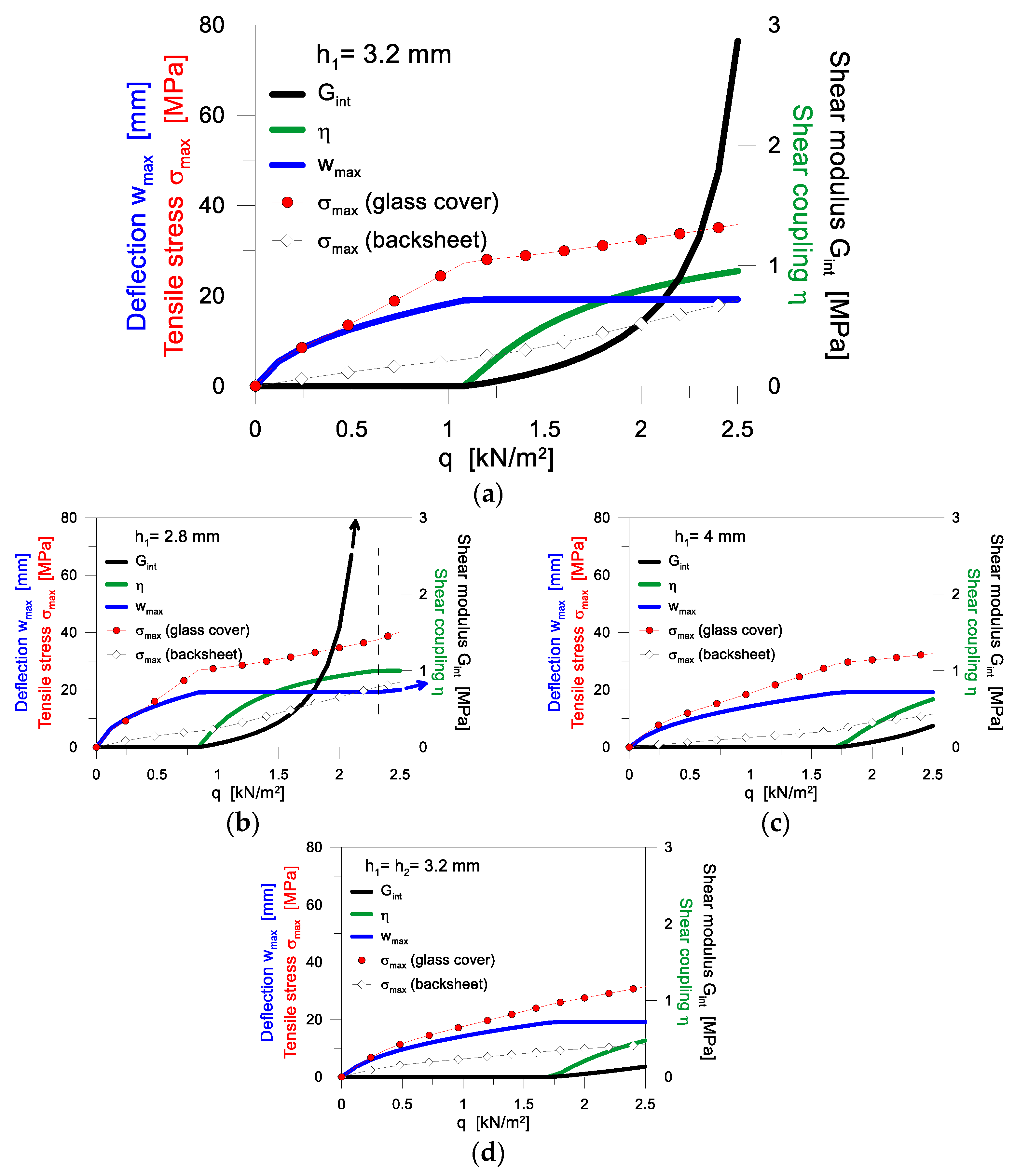
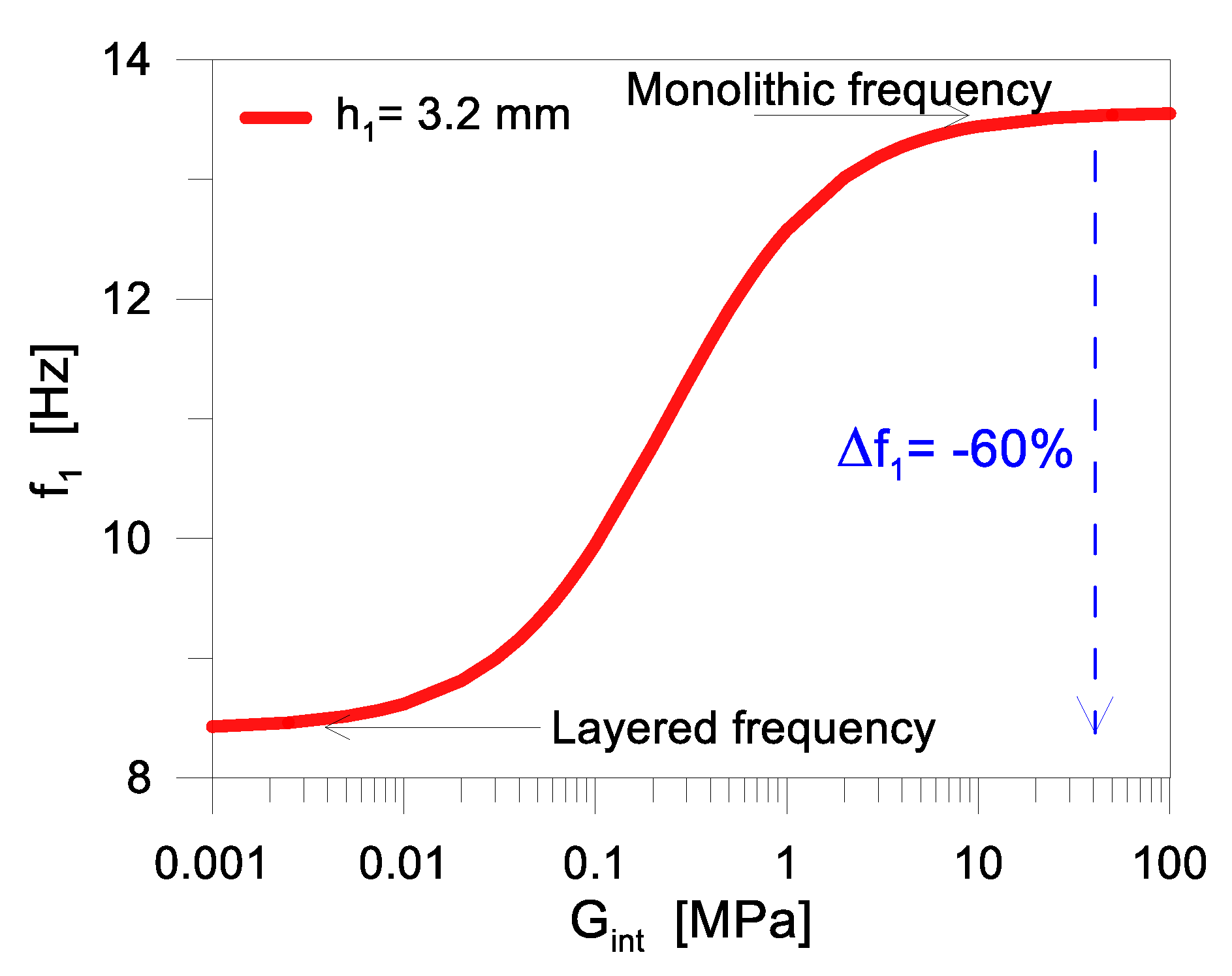

| Glass (Cover) | Tedlar® (Backsheet) | EVA (Encapsulant) | Solar Cells (Disregarded) | Aluminium Frame (Disregarded) | ||
|---|---|---|---|---|---|---|
| h | [mm] | 3.2 | 1 | 1 | 0.2 | Var. (Figure 4a) |
| E | [GPa] | 70 | 25 | 0.005 (var.) | 170 | 69 |
| ν | - | 0.23 | 0.3 | 0.49 | 0.25 | 0.3 |
| r | [kg/m3] | 2490 | 1000 | 950 | 2330 | 2700 |
Disclaimer/Publisher’s Note: The statements, opinions and data contained in all publications are solely those of the individual author(s) and contributor(s) and not of MDPI and/or the editor(s). MDPI and/or the editor(s) disclaim responsibility for any injury to people or property resulting from any ideas, methods, instructions or products referred to in the content. |
© 2024 by the authors. Licensee MDPI, Basel, Switzerland. This article is an open access article distributed under the terms and conditions of the Creative Commons Attribution (CC BY) license (https://creativecommons.org/licenses/by/4.0/).
Share and Cite
Bedon, C.; Santos, F.A.; Fasan, M. Mechanical Analysis of the Quasi-Static and Dynamic Composite Action in PV Modules with Viscoelastic Encapsulant. Materials 2024, 17, 1317. https://doi.org/10.3390/ma17061317
Bedon C, Santos FA, Fasan M. Mechanical Analysis of the Quasi-Static and Dynamic Composite Action in PV Modules with Viscoelastic Encapsulant. Materials. 2024; 17(6):1317. https://doi.org/10.3390/ma17061317
Chicago/Turabian StyleBedon, Chiara, Filipe A. Santos, and Marco Fasan. 2024. "Mechanical Analysis of the Quasi-Static and Dynamic Composite Action in PV Modules with Viscoelastic Encapsulant" Materials 17, no. 6: 1317. https://doi.org/10.3390/ma17061317






